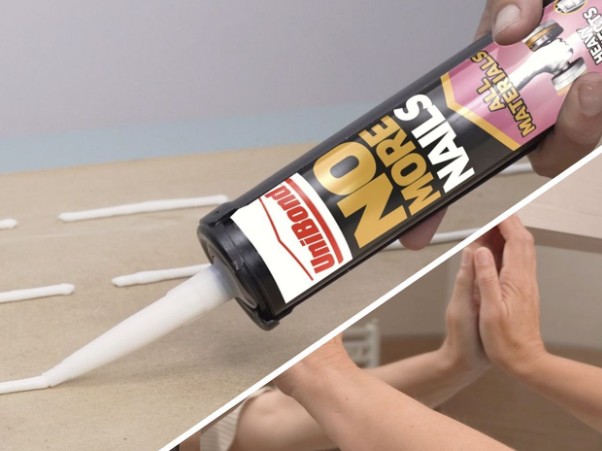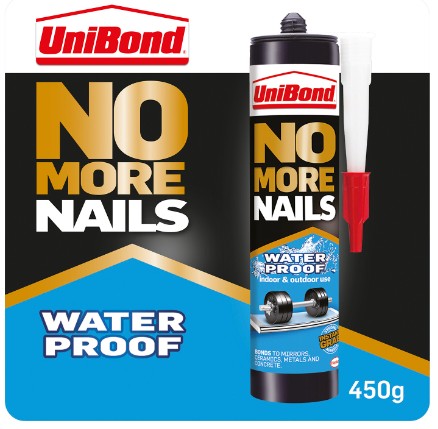Nails and screws alternatives like No More Nails are popular today because they minimize the need for screws and nails in many DIY and repair applications. However, you cannot use these alternatives in every application leading us to ask, can you use no more nails on bathroom tiles?
You can use No More Nails on your bathroom tiles, but it is not the most suitable adhesive for this application since it is made for light-duty projects. This general-purpose adhesive may not offer enough strength and adhesion for bathroom tiles.
Curious about using No More Nails on bathroom tiles? Read on for its definition and when and how to use it on your bathroom tiles.

When Can You Use No More Nails On Bathroom Tiles?
No More Nails (View on Amazon) is a popular construction adhesive designed to bond various materials like wood, metal, plastic, ceramic, stone, and more. This versatile adhesive is commonly used for multiple household and DIY projects.
It is often used for applications where nails or screws are not desirable or practical, such as attaching moldings, baseboards, paneling, or decorative items to walls. However, while it is reliable for many applications, it’s not suitable for every situation.
Regarding bathroom tiles, here are some instances where you can use No More Nails.
a) Mounting Small Accessories
You can use No More Nails to attach lightweight accessories like towel hooks, toothbrush holders, or soap dishes to your bathroom tiles.
b) Installing Mirror Frames
This adhesive will come in handy if you have a frameless mirror you’d like to mount on the bathroom wall. However, ensure the mirror and frame are lightweight because No More Nails cannot support heavy objects.
c) Securing Wall Panels
If your bathroom walls are covered with lightweight decorative panels or cladding, and you want to secure these panels to the tiles, No More Nails can provide a strong bond. However, ensure the adhesive is compatible with the tiles and the wall panels.
d) Light Tile-Related Bathroom Projects
No More Nails is not recommended for installing large or heavy tiles in a bathroom, so don’t use it as your primary tile adhesive. However, it can work for lightweight accessories.
Therefore, you can use it to reattach one or two loose bathroom tiles or cover holes or cracks on tiles. However, keep in mind that this adhesive will only offer a temporary fix.
When Shouldn’t I Use No More Nails on Bathroom Tiles?
As mentioned earlier, No More Nails is not ideal for every application in a bathroom. For that reason, here are the scenarios where using this adhesive on bathroom tiles is not suitable.
1. Heavy Or Large Tiles
No More Nails adhesive is not designed to hold heavy or large tiles. So, if you’re working with heavy tiles or those with significant dimensions, it’s best to use a tile adhesive formulated explicitly for the application you are dealing with.
Tile adhesives provide a stronger bond and better support for heavy tiles.
2. Wet Areas Or High Humidity
Use a waterproof tile adhesive for tiles in wet areas, such as shower enclosures or around bathtubs, to ensure long-lasting adherence. No More Nails adhesive is not formulated to withstand wet areas or high humidity conditions because such conditions can compromise its effectiveness.
c) Vertical Installations
No More Nails adhesive won’t provide sufficient strength to support tiles installed on a vertical surface. Therefore, pick a much stronger adhesive to install tiles on vertical surfaces, such as walls or backsplashes.
Vertical installations require adhesives with stronger bonding properties and better resistance against gravity and stress.
d) Long-term Durability
No More Nails adhesive can work for temporary or lightweight applications. However, it will not provide long-term durability for permanent tile installations.
For a secure and long-lasting tile installation, tile adhesives are better suited for the job.
e) Tiling Over Existing Tiles
If you intend to install new tiles over existing ones in your bathroom, choose a stronger adhesive than No More Nails. This is because No More Nails might not give a strong bond between the two layers of tiles, leading to instability and a higher risk of tiles becoming loose over time.
In fact, you are better off taking out existing tiles first before installing new ones.

Tips For Using No More Nails On Bathroom Tiles
Consider the following when using this adhesive on bathroom tiles.
i) Get The Surface Ready
The surface you want to apply the adhesive must be clean, dry, and grease, dirt, or dust-free. In that case, clean the tiles thoroughly before applying No More Nails to ensure a strong bond.
ii) Test On A Small Area
Before applying this adhesive to the entire surface, test it on a small, inconspicuous area of the bathroom tiles. This will allow you to assess the bond strength and ensure it works as desired.
iii) Apply In Small Amounts
Too much adhesive can make the installation messy and difficult to manage, so apply it in small amounts to avoid excessive squeeze-out.
iv) Apply Evenly
You want enough contact between the No More Nails and the tile surface. Therefore, spread the adhesive evenly on the back of the item you are attaching to the tiles using a putty knife or a similar tool.
v) Press Firmly And Hold
After applying No More Nails, press the item firmly against the tiles and hold it in place for the recommended amount of time specified by the manufacturer. This will let the adhesive set and form a strong bond.
vi) Allow Sufficient Curing Time
Give the adhesive enough time to cure and set before subjecting it to any stress or moisture. The manufacturer will provide instructions regarding the curing time.
What Are The Advantages Of Using No More Nails On Bathroom Tiles?
This adhesive is not formulated for bathroom tiles, but it’s a versatile product, and here are the advantages of using it in your bathroom.
a) Convenience
No More Nails is generally easy to use and does not require special tools or mixing like traditional tile adhesives or mortars. It comes in ready-to-use forms, such as tubes or squeeze bottles, making it convenient for minor repairs or DIY projects.
b) Versatility
This adhesive can bond various materials, like plastic, tiles, and wood. Therefore, it can be helpful when handling different bathroom applications, like attaching non-tile items such as decorative elements or lightweight objects to the tiles.
c) Removability
Removing No More Nails is easier than traditional tile adhesives or mortars. This can be beneficial if you need to make changes or repairs in the future without damaging the tiles.
Limitations Of Using No More Nails On Bathroom Tiles
There are several limitations and potential drawbacks of using No More Nails on your bathroom tiles.
1) It’s Not Moisture Resistant
The constant exposure to moisture and humidity in bathrooms can weaken the bond of No More Nails. This can lead to detachment, loosening of tiles, and potential water damage to the underlying surfaces.
2) Durability
Tile adhesives and mortars are specifically formulated to provide a solid and durable bond between tiles and the substrate. They are designed to withstand the stresses, temperature changes, and moisture commonly found in bathroom environments.
However, general-purpose adhesives like No More Nails do not offer the same level of long-term durability and performance.
3) Lack Of Flexibility
Tile installations may experience slight movements due to temperature fluctuations or structural settling. Fortunately, tile adhesives and mortars are designed to provide flexibility and accommodate these movements without compromising the bond.
The same cannot be said about No More Nails and other general-purpose adhesives. Therefore, using them on bathroom tiles can lead to cracks or tile detachment.
4) Limited Tile Compatibility
Different types of tiles require specific adhesives for proper bonding. For instance, larger or heavier tiles need stronger adhesives with higher bond strength.
No More Nails is not suitable for all types of tiles. Remember that using an adhesive incompatible with the specific tile material can lead to poor adhesion and potential tile failure.
5) Difficult Repairs Or Removal
Repairing or removing tiles attached to this adhesive can be challenging. This can result in additional time, effort, and potential damage to the tiles and surrounding areas during repairs or replacements.

Does No More Nails Stick To Tiles?
No More Nails can stick to tiles since it is designed to bond a variety of materials, including tiles. However, its bond strength and long-term durability on tiles will not be as reliable as adhesives formulated explicitly for tile installations.
This adhesive can stick to stone, ceramic, glass, and porcelain tiles. However, consider ROBERTS 5900-1 Ceramic Tile Adhesive (View on Amazon) if you have ceramic tiles. It’s premixed, ready to use, dries fast, spreads easily, and is simple to clean.
Can You Use No More Nails As A Sealant?
You cannot use No More Nails as a sealant because it is primarily designed as an adhesive. While it may have some limited sealing properties due to its adhesive nature, it is not specifically formulated or recommended as a sealant.
Its primary purpose is to bond materials together rather than provide a watertight or airtight seal.
How Long Does No More Nails Last Once Opened?
The shelf life of No More Nails is 12 months from the date of manufacture, provided it’s stored under the right conditions. Store the adhesive in a dry and cool place, away from direct sunlight and extreme temperatures, since it can help maintain its shelf life.
Once opened, this adhesive lasts for some time before it starts to degrade or lose effectiveness. However, ensure you properly seal the container after each use to prevent air exposure and drying out.
Concluding Thoughts on Can You Use No More Nails On Bathroom Tiles?
You can achieve temporary or semi-permanent bonds on your bathroom tiles using No More Nails, so use it for light applications. However, this adhesive can lose its grip after a while when used in areas with high humidity or exposed to moisture and water, like in the bathroom.
An adhesive intended for it is better when dealing with heavy-duty or load-bearing purposes.
Here are other interesting topics:
